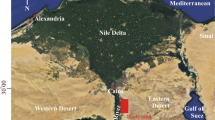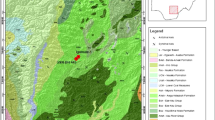Abstract
One stratigraphic section named Nimbolook succession in the northwest of Qayen city was measured and sampled. Based on identified foraminifera Berthelina intermedia assemblage zone, Rotalipora appenninica and Biticinella subbreggiensis interval zones were proposed. These biozones coincide with global biozones. According to foraminifera fauna, an Early–Late Albian age was suggested for this study. Palaeoecological studies led to the recognition of three benthic foraminifera (MG1–3) and two planktonic morphogroups (MG4–5). In the lower and middle part of the section, the abundance of benthic and agglutinated foraminifera (MG1–3) is more than planktonic foraminifera (MG4–5), respectively. Calcareous benthic morphogroups could be attributed to aerobic, shallow to slightly deep water, and eutrophic to mesotrophic environment. Agglutinated benthic morphogroups suggested that aerobic, mesotrophic, to eutrophic environments are characteristic by a dominance of arenaceous shallow infaunal specimens which are active deposit feeders. Planktonic foraminifera morphogroups with trochospiral and smooth test have been seen near the surface water, aerobic to semi-aerobic environment. Increasing planktonic foraminifera and specially keeled species could be a suggested recovery in paleoenvironmental conditions.










Similar content being viewed by others
References
Aghanabati A (2009) Geology of Iran geological survey of Iran. In Persian
Alavi M, compiler (1991) Tectonic map of the Middle East: geological survey of Iran scale1: 5,000,000
BabazadehS A, Raisossadat SN, Ahrari F (2010) Biostratigraphy and evolutionary study of the Cretaceous orbitolinids in the sedimentary deposits of east Lut, south west of Qayen. Sedimentary Facies 3(1):1–10 English Abstract
Berberian M, King GCP (1981) Towards a palaeogeography and tectonic evolution of Iran. Can J Earth Sci 18:210–265
Berthiaux A, Christmann P, Fauvelet E, Hatrival JN, Vaslet D, Vahdati Daneshmand A (1991) Quadrangle geological map of Qayen Scale: 1/250000 geological survey of Iran
Bindiu R, Filipescu S (2011) Agglutinated foraminifera from the northern TarcăuNappe. Studia UBB Geologia 56(2):31–41
Bolli HM (1966) Zonation of Cretaceous to Pliocene marine sediments based on planktonic foraminifera. Boletin Informativo Asociacion Venezolana de Geologia. MineriayPetroleo 9:9–32
BouDagher-Fadel MK (2015) Biostratigraphic and geological significance of planktonic foraminifera, Second Edition. UCL Press
Bronnimann P (1952) Globigerinidae from the upper Cretaceous (Cenomanian-Maestrichtian) of Trinidad. Bull Am Paleontol 34:5–71
Caron M (1985) Cretaceous Planktic foraminifera. In: Bolli H.M, Saunders J, Perch-Nielsen K, (eds) Plankton Stratigraphy 1: 17–86, Cambridge University
Caron M, Homewood P (1982) Evolution of early planktic foraminifers. Mar Micropaleontol 7:453–462
Coccioni R, Galeotti S (1993) Orbitally induced cycles in benthonic foraminiferal morphogroups and trophic structure distribution patterns from the Late Albian Amadeus Segment central Italy. J Micropalaeontol 12:227–239
Corfield RM, Hall MA, Brasier MD (1990) Stable isotope development for foraminiferal habitats during the development of the Cenomanian/Turonianoceanic anoxic event. Geology 18:175–178
Corliss BH, Chen C (1988) Morphotype patterns of Norwegian Sea deep sea benthic foraminifera and ecological implications. Geology 16:716–719
Eftekharnejad J (1981) Tectonic division of Iran with respect to sedimentary basins. J Iranian Petroleum Soc 82:19–28 [in Persian]
Eicher DL (1967) Foraminifera from Belle Fourche shale and equivalents Wyoming and Montana. J Paleontol 41(1):167–188
Eicher DL, Worstell P (1970) Cenomanian and Touronian foraminifera from the Great Plains United States. Micropaleontology 16:269–324
Erbacher J, Gerth W, Schmiedl G, Hemleben C (1998) Benthic foraminiferal assemblages of late Aptian-early Albian black shale intervals in the Vocontian Basin SE France. Cretac Res 19:805–826
Fauvelet E, Eftekhar-nezhad J (1990) Explanatory text of the Qayen, Quadrangle map 1: 250,000. Geological Survey of Iran 200 pp
Fisher CG, Arthur MA (2002) Water mass characteristics in the Cenomanian US western interior seaway as indicated by stable isotopes of calcareous organisms. Palaeogeogr Palaeoclimatol Palaeoecol 188:189–213
Friedrich O, Reichelt K, Herrle JO, Lehmann J, Pross J, Hemleben C (2003) Formation of the Late Aptian Niveau Fallot black shale in the Vocontian Basin SE France: evidence from foraminifera, palynomorphs, and stable isotopes. Mar Micropaleontol 49:65–85
Hardenbol J, Thierry J, Farley MB, Jacquin T, De Gracian-sky P-C, Vail PR (1998) Cretaceous sequence chronostratigraphy. In: De Graciansky P-C, Hardenbol J, Jacquin T, Vail PR (eds) Mesozoic and Cenozoic Sequence Stratigraphy of European Basins. Special Publication Society Sedimentary Geology 60 (chart)
Hart MB (1999) The evolution and biodiversity of Cretaceous planktonic Foraminiferida. Geobios 32(2):247–255
Hart MB, Bailey HW (1979) The distribution of planktonic Foraminiferida in the Mid-Cretaceous of NW Europe. Int Union Geol Sci Seri A 6:527–542
Holbourn A, Kaminski M (1997) Lower Cretaceous deep-water foraminifera of Indian Ocean. Grzybowski Foundation Special Publication No 4:172 p
Jarvis I, Carson GA, Cooper MKE, Hart MB, Leary PN, Tocher BA, Horne D, Rosenfeld A (1988) Microfossil assemblages and the Cenomanian-Turonian Late Cretaceous oceanic anoxic event. Cretac Res 9:3–103
Keller G, Pardo A (2004) Age and paleoenvironment of the Cenomanian–Turonian global stratotype section and point at Pueblo Colorado. Mar Micropaleontol 51:95–128
Khazaei A, Raisossadat SN, Asadi S (2011) Rudist bivalves (Requieniidae family) in Early Cretaceous sediments from SW Qayen Eastern Iran, Paleobiogeographic aspects. Sedimentary Facies 3(2):52–67 English Abstract
Kochhann KGD, Koutsoukos DAM, Fauth G, Sial AN (2013) Aptian–Albian planktic foraminifera from DSDP site 365564 (offshore Angola): biostratigraphy, paleoecology and palebroceanographic significance. J Foraminifer Res 43(4):443–463
Kochhann KGD, Koutsoukos EAM, Fauth G (2014) Aptian-Albian benthic foraminifera from DSDP site 364 (offshoreAngola): a paleoenvironmental and paleobiogeographic appraisal. Cretac Res 48:1–11
Koutsoukos EAM, Hart MB (1990) Cretaceous foraminiferal morphogroup distribution patterns palaeocommunities and trophic structures: a case study from the Sergipe Basin, Brazil. Trans R Soc Edinb Earth Environ Sci 81:221–246
Leary PN, Carson GA, Cooper MKE, Hart MB, Horne D, Jarvis I, Rosenfeld A, Tocher BA (1989) The biotic response to the late Cenomanian oceanic anoxic event integrated evidence from Dover SE England. J Geol Soc Lond 146:311–317
Leckie RM (1985) Foraminifera of the Cenomanian-Turonian boundary interval Greenhorn formation Rock Cabyon Atlantic Peublo Colorado. In: Pratt LM, Kauffman EG, and Zelt F (eds.) Fine-Grained Deposits and Biofacies of the Cretaceous Western Interior Seaway Evidence of Cyclic Sedimentary Processes. Soc. Econ. Min. and Paleontol. Field Trip Guide book No. 4, 139–149
Leckie RM (1987) Paleoecology of mid-Cretaceous foraminifera, a comparison of open ocean and epicontinental sea assemblages. Micropaleontology 33:164–176
Leckie RM (1989) Apaleoceanographic model for the early evolutionary history of planktonic foraminifera. Palaeogeogr Palaeoclimatol Palaeoecol 73:107–138
LoweryCh M, Corbett MJ, Leckie RM, Watkins D, Romero AM, Pramudito A (2014) Foraminiferal and nannofossilpaleoecology and paleoceanography of the Cenomanian–Turonian eagle ford shale of southern Texas. Palaeogeogr Palaeoclimatol Palaeoecol 413:49–65
Moullade M (1974) Zones de Foraminifères de Crétacéinférieurmésogéen. C R Acad Sci Paris Ser D 278:1813–1816
Nabavi MH (1976) An introduction to geology of Iran. Geological survey of Iran (In Persian)
Nagy J (1992) Environmental significance of foraminiferalmorphogroups in Jurassic North Sea deltas. Palaeogeogr Palaeoclimatol Palaeoecol 95:111–134
Nogole-Sadat MAA, Almasian M (1993) Tectonic map of Iran. Scale 1:1,000,000. Geological Survey of Iran
Norris RD, Wilson PA (1998) Low-latitude sea-surface temperatures for the mid-Cretaceous and the evolution of planktic foraminifera. Geology 26(9):823–826
Postuma JA (1971) Manual of planktonic foraminifera. Elsevier Publishing Company
Premoli Silva I, Sliter WV (1999) Cretaceous paleoceanography evidence from planktonic foraminiferal evolution. Geol Soc Am Spec Pap 332:301–328
Premoli Silva I, and Verga D (2004) Practical manual of Cretaceous planktonic foraminifera.International School on planktonic foraminifera 3 course Cretaceous Universities of Perugia and Milan Perugia 283 pp
Price GD, Hart MB (2002) Isotopic evidence for early to mid-Cretaceous ocean temperature variability. Mar Micropaleontol 46:45–58
Raisossadat SN, Skelton PW (2005) First record of rudist fauna from the Qayen area Eastern Iran. 7th International Cretaceous Symposium, Neuchatel, Switzerland
Raisossadat SN, Mosavinia A, Khazaei AR, Asadi Sh, (2011) Stratigraphy of Cretaceous deposits in Southwest of Qayen area (East of Iran). Proceeding of the 5th Symposium of Iranian Paleontological Society [English Abstract]
Raisossadat SN Asadi Sh, Zarei H, Khazaei AR, Mortazavi M, Motamedalshariati M, Mosavinia A, Moloudi D, Yazdi Moghadam M (2014) Stratigraphy paleoecology and paleobiogeography of Cretaceous deposits in the east of Lut Block (Qayen area). Proceeding of 18th Symposium of Geological Society of Iran, 600–610, Tarbiat Modarres University, Iran
Rückheim S, Bornemann A, Mutterlose J (2006) Planktic foraminifera from the mid-Cretaceous (Barremian–Early Albian) of the North Sea basin. Palaeoecological and palaeoceanographic implications. Mar Micropaleontol 58:83–102
Sigal J (1977) Essai de Zonation du Cr’etac’eme’diterraneen a l’aide des foraminifers planctoniques. Géol Mediterr 4:99–108
Stocklin J (1968) Structural history and tectonics of Iran: a review. Am Assoc Pet Geol Bull 52:1229–1258
Van der Zwaan GJ, Duijnstee IAP, den Dulk M, Ernst SR, Jannink NT, Kouwenhoven TJ (1999) Benthic foraminifers: proxies or problems? A review of paleoecologicalconcepts. Earth-Sci Rev 46:213–236
Van Hinte JE (1976) A Cretaceous time scale. Am Assoc Pet Geol Bull 60(4):498–516
Weidich KF (1990) Die kalkalpine unterkreide und ihre foraminiferen fauna. Zitteliana 17:1–312
Wiedmann J, Butt A, Einsele G (1982) Cretaceous stratigraphy environment and subsidence history at the Moroccan continental margin. In: von Rad U et al (eds) Geology of the northwest African continental margin. Springer, Berlin, pp. 336–395
Zarei H, Raisossadat SN Yazdi Moghadam M, Mortazavi Mehrizi M, (2014) Lower Cretaceous paleoecology in the Qomenjan section, southwest Qayen, based on benthic foraminifera. Proceeding of the 8th Symposium of Iranian Paleontological Society, 21–22 May 2014, Zanjan University, Zanjan, Iran
Acknowledgments
Comments by two anonymous reviewers were highly appreciated and significantly improved this manuscript. We thank Dr. Brian Huber and Ann Holbourn for their comments in identifying some specimens and providing some useful papers. We appreciate the Department of Geology, University of Birjand for providing laboratory facilities and some logistic support in the course of the field work.
Author information
Authors and Affiliations
Corresponding author
Rights and permissions
About this article
Cite this article
Motamedalshariati, M., Raisossadat, S.N., Moluodi, D. et al. Foraminifera biozonation and morphogroups from Nimbolook section, east margin of Lut block, Iran. Arab J Geosci 9, 720 (2016). https://doi.org/10.1007/s12517-016-2709-y
Received:
Accepted:
Published:
DOI: https://doi.org/10.1007/s12517-016-2709-y




